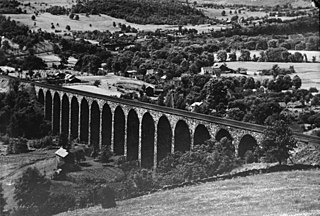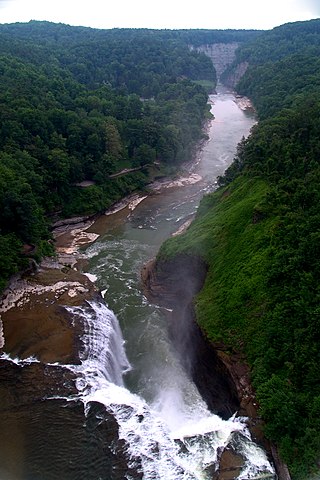
Letchworth State Park is a 14,427-acre (5,838 ha) New York State Park located in Livingston County and Wyoming County in the western part of the State of New York. The park is roughly 17 miles (27 km) long, following the course of the Genesee River as it flows north through a deep gorge and over several large waterfalls. It is located 35 miles (56 km) southwest of Rochester and 60 miles (97 km) southeast of Buffalo, and spans portions of the Livingston County towns of Leicester, Mount Morris and Portage, as well as the Wyoming County towns of Castile and Genesee Falls.
Portageville is a hamlet located in the town of Genesee Falls in Wyoming County, New York, United States. Its name derives from the Native American canoeists who would withdraw their craft from the river to avoid going over three waterfalls in the Genesee River gorge now known as Portage Falls. They had to portage several miles to the site of present-day Mount Morris, where they could embark for the rest of the journey downriver.

Genesee Falls is an incorporated town in Wyoming County, New York. The population was 438 at the 2010 census.

The Genesee River is a tributary of Lake Ontario flowing northward through the Twin Tiers of Pennsylvania and New York in the United States. The river contains several waterfalls in New York at Letchworth State Park and Rochester.
Portage is a town in the southwest corner of Livingston County, New York, United States. The town is at the south end of Letchworth State Park. The name of the town stems from the need to portage (carry) canoes around the falls of the Genesee River. The population of Portage was 884 at the 2010 census.

The Delaware, Lackawanna and Western Railroad, also known as the DL&W or Lackawanna Railroad, was a U.S. Class 1 railroad that connected Buffalo, New York, and Hoboken, New Jersey, and by ferry with New York City, a distance of 395 miles (636 km). The railroad was incorporated in Pennsylvania in 1853, and created primarily to provide a means of transport of anthracite coal from the Coal Region in Northeast Pennsylvania to large coal markets in New York City. The railroad gradually expanded both east and west, and eventually linked Buffalo with New York City.

A trestle bridge is a bridge composed of a number of short spans supported by closely spaced frames. A trestle is a rigid frame used as a support, historically a tripod used to support a stool or a pair of isosceles triangles joined at their apices by a plank or beam such as the support structure for a trestle table. Each supporting frame is a bent. A trestle differs from a viaduct in that viaducts have towers that support much longer spans and typically have a higher elevation.

The Genesee Valley Canal is a former canal that operated in western New York between 1840 and 1878. It ran for a length of 124 miles, passing through 106 locks. Its course was later used by the Genesee Valley Canal Railroad and today comprises portions of the Genesee Valley Greenway.

The Delaware-Lackawanna Railroad is a shortline railroad operating in Northeastern Pennsylvania, especially the Scranton area.

The American Bridge Company is a heavy/civil construction firm that specializes in building and renovating bridges and other large, complex structures. Founded in 1900, the company is headquartered in Coraopolis, Pennsylvania, a suburb of Pittsburgh. The firm has built many bridges in the U.S. and elsewhere; the Historic American Engineering Record notes at least 81. American Bridge has also built or helped build the Willis Tower, the Empire State Building, the Chrysler Building, launch pads, resorts, and more. During World War II, it produced tank landing ships (LSTs) for the United States Navy. In 2020, American Bridge Company was acquired by Southland Holdings LLC.

New York State Route 19A (NY 19A) is a north–south state highway in western New York in the United States. It is an alternate route of NY 19 between the town of Hume and the vicinity of the village of Silver Springs. NY 19A also serves the community of Portageville and the village of Castile. The portion of NY 19A south of Portageville closely follows the Genesee River. North of Portageville, the route parallels the Southern Tier Line. NY 19A was assigned as part of the 1930 renumbering of state highways in New York.

New York State Route 436 (NY 436) is an east–west state highway located in the western portion of New York in the United States. It extends for 23.80 miles (38.30 km) from an intersection with NY 39 in the Pike hamlet of Lamont to a junction with NY 36 in the village of Dansville. In between, the route passes through Letchworth State Park near its southern tip and serves the village of Nunda, where it meets NY 408. NY 436 also passes through the hamlet of Portageville, located at the southern end of Letchworth State Park on NY 19A, which NY 436 overlaps north of the community. Most of NY 436 is a two-lane highway that traverses largely rural areas of Wyoming and Livingston counties.

Starrucca Viaduct is a stone arch bridge that spans Starrucca Creek near Lanesboro, Pennsylvania, in the United States. Completed in 1848 at a cost of $320,000, it was at the time the world's largest stone railway viaduct and was thought to be the most expensive railway bridge as well. Still in use, the viaduct is listed on the National Register of Historic Places and is designated as a National Historic Civil Engineering Landmark.

Tunkhannock Creek Viaduct is a concrete deck arch bridge on the Nicholson Cutoff rail line segment of the Norfolk Southern Railway Sunbury Line that spans Tunkhannock Creek in Nicholson, Pennsylvania. Measuring 2,375 feet (724 m) long and towering 240 feet (73.15 m) when measured from the creek bed, it was the largest concrete structure in the world when completed in 1915 and still merited "the title of largest concrete bridge in America, if not the world" 50 years later.

The Genesee Valley Greenway is a rail trail in western New York's Genesee River valley.

The Kinzua Bridge or the Kinzua Viaduct was a railroad trestle that spanned Kinzua Creek in McKean County in the U.S. state of Pennsylvania. The bridge was 301 feet (92 m) tall and 2,052 feet (625 m) long. Most of its structure collapsed during a tornado in July 2003.

The Blackstone Viaduct, or the New York & New England Railroad Viaduct is a historic viaduct in Blackstone, Massachusetts. The viaduct was built in 1872 by the Boston, Hartford and Erie Railroad and the American Bridge Company. The viaduct is 1,600 feet (490 m) long structure, consisting of masonry arches and earthen embankments in the Massachusetts portion of the village of Waterford. It runs from the Blackstone River in the east to a still-watered section of the defunct Blackstone Canal to the west. The most prominent portion of the structure is an 800-foot earthen embankment running west from the river that is 25 feet (7.6 m) high, and then a 375-foot (114 m) multiple-arch masonry bridge constructed out of granite which was sheathed in concrete in 1918. The structure was listed on the National Register of Historic Places in 2002.

The Glen Iris Inn, William Pryor Letchworth's former home, is located on the top of a cliff overlooking Middle Falls in Letchworth State Park, New York State, USA. William Letchworth found the day-to-day operations of business burdensome and sought refuge on the site, where he decided to build a home. He settled on the location while seeing it from a high railroad bridge as a tourist on an Erie Railroad passenger train, gazing at the view in what the Seneca Indians called the Sehgahunda Valley, through which the Genesee River flowed. In 1859, he purchased his first tract of land near Portage Falls.

Youngstown and Austintown Railroad is a short-line railroad that operates just west of Youngstown, Ohio, United States, and was acquired by Genesee & Wyoming Inc. in 2008. It interchanges with the Youngstown Belt Railroad and Norfolk Southern in Youngstown, Ohio, as well as CSX in Yanda, Ohio. Acquired by Genesee & Wyoming in 2008, the Youngstown and Austintown Railroad spans across 5 miles of track and can hold up to 286,000 pounds of supplies. The YARR is essentially two former Erie Railroad branch lines. The line come together at M&T Jct.. The lines are very short and they service the steel industry in Youngstown. For years the largest customer on the YARR was Youngstown Steel Door and United Freezer Storage. The first operator of the YARR was Jerry Jacobson. The original YARR rostered an Alco switcher and former P&LE GP7 1501. The one-stall enginehouse still stands today in Austintown on Oakwood Ave. A small section of the structure was constructed by the Erie railroad.

Portage Falls are three large waterfalls located along the Genesee River. The falls are by the Genesee Arch Bridge and run through Letchworth State Park. William Pryor Letchworth once owned a tract and built his Glen Iris Estate in the area that is now part of the park. The town of Portage, New York and the hamlet of Portageville are nearby.






















